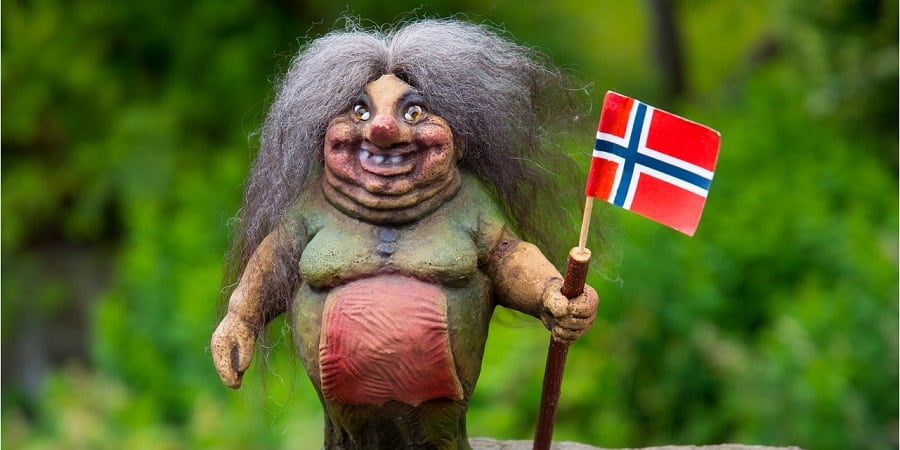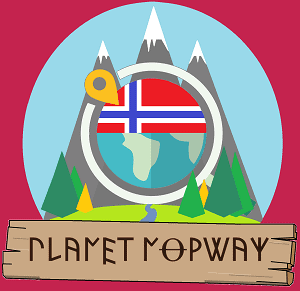Nowadays, a troll is typically associated with someone who intentionally says something to provoke others in person or online, known as trolling. However, the original troll comes from Norwegian and Scandinavian folklore.
If you have been to Norway, you probably wandered into a gift shop where you were presented with all sorts of troll memorabilia. Also, there are several landmarks in Norway named troll-something, like the troll’s tongue, and Trollstigen.
So what are these creatures really? And why are they such a permanent fixture in Norwegian folklore and culture? Let’s find out

Mythology
A troll is a supernatural creature that is mentioned in several sagas, fairytales, and legends in Norwegian culture. While they are often depicted as being large, monster-like creatures, they can also appear as humans with special abilities or small, dwarf-like creatures.
Common to all is that they are anti-social, night-time creatures often living in secluded areas such as the deep forest or up in the mountains.
Trolls are mentioned throughout writings central to Norse mythology. Here they are said to dwell in isolated mountains, rocks, and caves. They can sometimes live together in family-like groups but are rarely described as being friendly or helpful toward humans.
Later, after the Christianization of Norway, trolls were more associated with, ghosts/spirits, human-like demons, and witchery. Anyone accused of having contact with trolls could be punished. During the witch hunts of the late middle ages, many were trialed and executed for practicing witchcraft (trolldom).
During the 17th century, the trolls were gradually being rendered less harmful and dangerous. Often being depicted as stupid spectacular fantasy figures, often portrayed as multi-headed beings. While these trolls were still frightening to small children in fairytales, for most Norwegians they became almost romanticized figures which gave rise to the tourist symbol it is today.
Most famous trolls
As mentioned, trolls can come n different shapes and sizes. However, we can separate between 2 main types, forest trolls, and mountain trolls. These are very wide categories that contain a wide range of subcategories with different looks and traits.
Some of them have made their way into fairytales and legends that are told to this day.
Dovregubben
Dovregubben is a character from Henrik Ibsen’s Peer Gynt from 1867, a dramatic poem inspired by Norwegian folk poetry. In the poem, he is said to be a powerful troll king who rules over his subordinates within his hall (Dovregubbens hall) deep inside the Rondane mountain range.
In the poem, Dovregubben represents the narrow-minded and self-righteous, which can be interpreted as a satirical symbol of both the closed-off and self-asserted Norwegian.
The trolls in the fairy tales of Askeladden
The main character and hero of many traditional Norwegian fairy tales is Espen Akeladden (known as Ashlad). He is the typical underdog who starts out being regarded as an incapable underachiever but eventually proves himself by overcoming some prodigious deed, succeeding where all others have failed.
In several tales about Ashlad he encounters a vicious and dangerous troll that he has to overcome. One of them is the forest troll. According to the tale, Ashlad challenges the troll to an eating competition during which he urges the troll into opening his own stomach with a knife in order to eat more. Being rather stupid, the troll did so and promptly died, after which Ashlad took all of his gold and silver.
Huldra
Huldra is a supernatural female being who can be considered a troll. She is mentioned in several legends throughout the country, most of which are from the forests of southeast Norway.
She is described as a human-like beautiful maiden with long golden hair, but unlike humans she has a long tail, resembling that of a cow. She is said to appear in the mountains or in the forest, often to men which she seduces with her beauty and voice never to be seen again.
Nøkken (Neck)
Nøkken is a personification of the dangers of water. He is a vicious and scary, man-like troll that resides in rivers, lakes, and ponds. Here he seeks to lure people into the water to drown them. Because of this, it is said that when nøkken howls, it is a warning that a human is about to down.
Nøkken is especially dangerous after sundown. However, if you are able to identify him you can protect yourself by calling him out by his name, after which he loses all his seductive powers.
Final words
With such a long and rich history tied to the region, there’s no wonder why trolls remain such an important figure in Norwegian culture to this day.
This has in turn helped trolls become well-known outside Scandinavia as well. From harry potter to the lord of the rings and frozen. The trolls made their way into popular culture and English vocabulary.
And while their appearance and behavior are presented in all sorts of ways, they all have something in common with the ancient, mythological Scandinavian troll.
